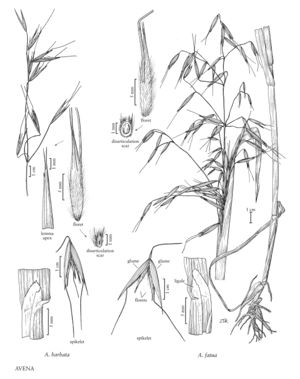Difference between revisions of "Avena fatua"
FNA>Volume Importer |
imported>Volume Importer |
||
| (2 intermediate revisions by the same user not shown) | |||
| Line 24: | Line 24: | ||
-->{{Treatment/Body | -->{{Treatment/Body | ||
| − | |distribution=Conn.;N.J.;N.Y.;Wash.;W.Va.;Del.;Wis.;Idaho;Mont.;Oreg.;Wyo.;Pacific Islands (Hawaii);Fla.;N.H.;N.Mex.;Tex.;La.;Alta.;B.C.;Man.;N.B.;Nfld. | + | |distribution=Conn.;N.J.;N.Y.;Wash.;W.Va.;Del.;Wis.;Idaho;Mont.;Oreg.;Wyo.;Pacific Islands (Hawaii);Fla.;N.H.;N.Mex.;Tex.;La.;Alta.;B.C.;Man.;N.B.;Nfld. and Labr. (Labr.);N.S.;N.W.T.;Ont.;P.E.I.;Que.;Sask.;Tenn.;Pa.;Calif.;Nev.;Va.;Colo.;Alaska;Ala.;Vt.;Ill.;Ind.;Iowa;Okla.;Ariz.;N.Dak.;Nebr.;S.Dak.;Maine;Md.;Mass.;Ohio;Utah;Mo.;Minn.;Mich.;Kans.;Miss.;Ky. |
|discussion=<p><i>Avena fatua</i> is native to Europe and central Asia. It is known as a weed in most temperate regions of the world; it is considered a noxious weed in some parts of Canada and the United States.</p><!-- | |discussion=<p><i>Avena fatua</i> is native to Europe and central Asia. It is known as a weed in most temperate regions of the world; it is considered a noxious weed in some parts of Canada and the United States.</p><!-- | ||
--><p><i>Avena fatua</i> is sometimes confused with <i>A. occidentalis</i>, but differs in having shorter, wider spikelets, fewer florets, and a distal floret which does not have a heart-shaped disarticulation scar. Hybrids between <i>A. fatua</i> and <i>A. sativa</i> are common in plantings of cultivated oats. The hybrids resemble <i>A. sativa</i>, but differ in having the fatua-type lodicule; some also have a weak awn on the first lemma. They are easily confused with fatuoid forms of <i>A. sativa</i>.</p> | --><p><i>Avena fatua</i> is sometimes confused with <i>A. occidentalis</i>, but differs in having shorter, wider spikelets, fewer florets, and a distal floret which does not have a heart-shaped disarticulation scar. Hybrids between <i>A. fatua</i> and <i>A. sativa</i> are common in plantings of cultivated oats. The hybrids resemble <i>A. sativa</i>, but differ in having the fatua-type lodicule; some also have a weak awn on the first lemma. They are easily confused with fatuoid forms of <i>A. sativa</i>.</p> | ||
| Line 43: | Line 43: | ||
|illustrator=Cindy Roché | |illustrator=Cindy Roché | ||
|illustration copyright=Utah State University | |illustration copyright=Utah State University | ||
| − | |distribution=Conn.;N.J.;N.Y.;Wash.;W.Va.;Del.;Wis.;Idaho;Mont.;Oreg.;Wyo.;Pacific Islands (Hawaii);Fla.;N.H.;N.Mex.;Tex.;La.;Alta.;B.C.;Man.;N.B.;Nfld. | + | |distribution=Conn.;N.J.;N.Y.;Wash.;W.Va.;Del.;Wis.;Idaho;Mont.;Oreg.;Wyo.;Pacific Islands (Hawaii);Fla.;N.H.;N.Mex.;Tex.;La.;Alta.;B.C.;Man.;N.B.;Nfld. and Labr. (Labr.);N.S.;N.W.T.;Ont.;P.E.I.;Que.;Sask.;Tenn.;Pa.;Calif.;Nev.;Va.;Colo.;Alaska;Ala.;Vt.;Ill.;Ind.;Iowa;Okla.;Ariz.;N.Dak.;Nebr.;S.Dak.;Maine;Md.;Mass.;Ohio;Utah;Mo.;Minn.;Mich.;Kans.;Miss.;Ky. |
|reference=None | |reference=None | ||
|publication title= | |publication title= | ||
|publication year= | |publication year= | ||
|special status= | |special status= | ||
| − | |source xml=https:// | + | |source xml=https://bitbucket.org/aafc-mbb/fna-data-curation/src/200273ad09963decb8fc72550212de541d86569d/coarse_grained_fna_xml/V24/V24_1043.xml |
|subfamily=Poaceae subfam. Pooideae | |subfamily=Poaceae subfam. Pooideae | ||
|tribe=Poaceae tribe Poeae | |tribe=Poaceae tribe Poeae | ||
Latest revision as of 17:21, 11 May 2021
Plants annual. Culms 8-160 cm, prostrate to erect when young, becoming erect at maturity. Sheaths of the basal leaves with scattered hairs, upper sheaths glabrous; ligules 4-6 mm, acute; blades 10-45 cm long, 3-15 mm wide, scabridulous. Panicles 7-40 cm long, 5-20 cm wide, nodding. Spikelets 18-32 mm, with 2(3) florets; disarticulation beneath each floret; disarticulation scars of all florets round to ovate or triangular. Glumes subequal, 18-32 mm, 9-11-veined; calluses bearded, hairs to 1/4 the length of the lemmas; lemmas 14-22 mm, usually densely strigose below midlength, sometimes sparsely strigose or glabrous, veins not extending beyond the apices, apices usually bifid, teeth 0.3-1.5 mm, awns 23-42 mm, arising in the middle 1/3 of the lemmas; lodicules without lobes on the wings; anthers about 3 mm. 2n = 42.
Distribution
Conn., N.J., N.Y., Wash., W.Va., Del., Wis., Idaho, Mont., Oreg., Wyo., Pacific Islands (Hawaii), Fla., N.H., N.Mex., Tex., La., Alta., B.C., Man., N.B., Nfld. and Labr. (Labr.), N.S., N.W.T., Ont., P.E.I., Que., Sask., Tenn., Pa., Calif., Nev., Va., Colo., Alaska, Ala., Vt., Ill., Ind., Iowa, Okla., Ariz., N.Dak., Nebr., S.Dak., Maine, Md., Mass., Ohio, Utah, Mo., Minn., Mich., Kans., Miss., Ky.
Discussion
Avena fatua is native to Europe and central Asia. It is known as a weed in most temperate regions of the world; it is considered a noxious weed in some parts of Canada and the United States.
Avena fatua is sometimes confused with A. occidentalis, but differs in having shorter, wider spikelets, fewer florets, and a distal floret which does not have a heart-shaped disarticulation scar. Hybrids between A. fatua and A. sativa are common in plantings of cultivated oats. The hybrids resemble A. sativa, but differ in having the fatua-type lodicule; some also have a weak awn on the first lemma. They are easily confused with fatuoid forms of A. sativa.
Selected References
None.
